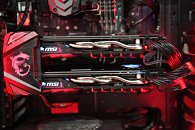Monday, May 30th 2016

MSI Gaming Custom-design SLI HB Bridge Pictured
Here some of the first pictures of an NVIDIA add-in card (AIC) partner branded SLI-HB (high-bandwidth) bridge. This kind of bridge is recommended for use with GeForce "Pascal" graphics cards, at high resolutions, such as 4K @ 60 Hz with HDR, 4K @ 120 Hz, 5K, and above. Pictured here is a 2-way SLI HB bridge with 2U spacing (1-slot gap between the two cards). The bridge appears to have a red LED of its own, lighting up the MSI Gaming dragon logo. At this point it's not clear whether the bridge comes included with the cards, or if it needs to be purchased separately. The cards being bridged in these pictures are the MSI GeForce GTX 1080 Gaming Z, a notch above the GTX 1080 Gaming X the company debuted its custom GTX 1080 lineup with.


12 Comments on MSI Gaming Custom-design SLI HB Bridge Pictured
please....
Really a new bridge for increase bandwidth,! Is this another marketing hyper?
Just messing, who knows!
Nvidia says the bridge is needed, wouldnt surprise me if making SLI work without a bridge would require tons of R+D to change how it works. TLDR: if it aint broke, dont fix it.
so 2.5/3 fingers, use all for more bandwidth ?